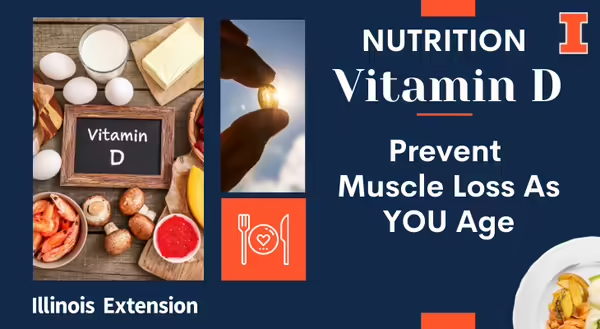
Aging well is a goal for many, as it allows us to enjoy all life has to offer well into our golden year. When it comes to aging well, like many things in life, if we are going to be successful, we need to have a plan. If the goal is simply to eat healthily, stay active, and be grateful, you are well on your way to success. However, if you are looking for an extra edge to help combat age-related muscle loss and stay active, let's look at vitamin D.
Vitamin D
Vitamin D has been in the news a lot over the past decade. This is because vitamin D is a unique nutrient, and researchers have been working to unlock its true value.
What makes this nutrient unique?
For starters, it is both a fat-soluble vitamin and a hormone made by the body from sun exposure. Thus, it is commonly called the sunshine vitamin. Vitamin D is generally associated with bone health. However, it serves many important roles and functions throughout the body. In addition to helping build and maintain healthy, strong bones, it helps regulate inflammation and has been shown to reduce the risk of certain cancers such as breast, colon, and prostate. Additionally, vitamin D plays a vital in the function of the immune system and nerve and muscle function.
Research has shown vitamin D plays an essential role in the health of our skeletal muscles. In fact, low serum levels of vitamin D are associated with reduced muscle strength and function, leading to muscle loss, and decreased production of cells needed to build muscle. When there is a loss of muscle strength, function, and ability to build muscle cells, individuals are at increased risk of falls due to muscle weakness. This makes sense if your body is not making and maintaining its muscles' stores; you will not have the strength and endurance to move around and do the things you love most.
What does all this mean?
Simply put, be intentional about getting adequate amounts of vitamin D in your diet and get tested to determine if your vitamin D stores are low. Unfortunately, vitamin D deficiency is more common than one would think; about 42% of the U.S. population has low vitamin D levels – so the question is, are you one of them?
Food rich in Vitamin D
Vitamin D is not naturally present in many foods. Thus, food manufacturers have added or fortified foods with vitamin D for many years.
Sources of vitamin D
- Mushrooms
- Egg yolks
- Saltwater fish
- Beef liver
- Cod liver oil
- Fatty fish
- Herring
- Sardines
- Salmon
- Mackerel
- Tuna
Fortified foods and beverages
- Dairy products
- Milk
- Cheese
- Yogurt
- Cereals
- Juices
- Tofu
- Milk substitutes (soy and almond beverages)
Of course, more research is needed to truly determine the role vitamin D plays in our overall health. However, the exciting news is – we know now more than we did years ago! I think it will be fun in the coming years to read and learn more about vitamin D and the exact role vitamin D supplements play in preventing and treating sarcopenia.
With all that said, remember, it's not just about one nutrient, one food, or one eating occurrence – it's about a lifetime of choices. So, move more today than you did yesterday. Enjoy the foods YOU choose, but choose wisely and remember portion size matters.
ABOUT THE AUTHOR: Diane Reinhold, MPH, MS, RDN, is a Nutrition and Wellness Educator with University of Illinois Extension, serving Jo Daviess, Stephenson, and Winnebago Counties. Diane is a registered dietitian nutritionist providing evidence-based programming focused on chronic disease prevention and management and food safety.
References
Bartoszewska, M., Kamboj, M., & Patel, D. R. (2010). Vitamin D, muscle function, and exercise performance. Pediatric Clinics, 57(3), 849-861. doi:10.1016/j.pcl.2010.03.008
Remelli, F., Vitali, A., Zurlo, A., & Volpato, S. (2019). Vitamin D Deficiency and Sarcopenia in Older Persons. Nutrients, 11(12), 2861. https://doi.org/10.3390/nu11122861
Wartenberg, L. (2022, March 10). Vitamin D deficiency: Symptoms, treatments, and causes. Healthline. Retrieved May 4, 2022, from https://www.healthline.com/nutrition/vitamin-d-deficiency-symptoms#:~:text=Vitamin%20D%20deficiency%20is%20extremely,1%20%2C%202%20%2C%203%20).